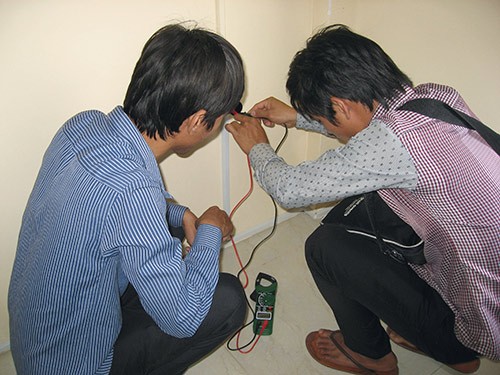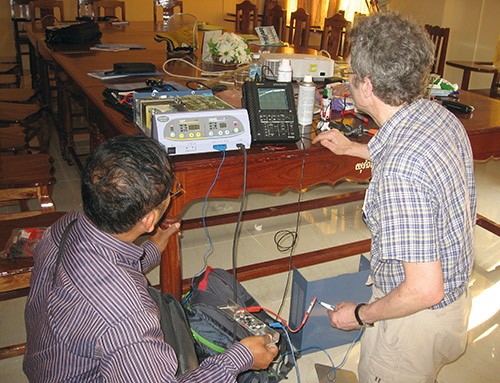Generous donors help provide local hospitals and health centres in the poor regions of the world with sophisticated diagnostic and therapeutic equipment. The users receive training in how to use the equipment, but maintenance and knowledge about the hazards of using electrical systems are not considered. Medical-technical equipment can thus represent a health risk to patients and staff alike.

Tromsø Mine Victim Resource Centre (TMC), of which I am the director, has provided training in pre-hospital trauma care in the Battambang province in north-western Cambodia since 1996 (1). The province is home to approximately one million of the country’s 14 million inhabitants, and its rural areas were mined and bombed through decades of war and conflict until the late 1990s. The civilian population still has a very hard life, and in some areas more than 30 % of all adult men are single or double amputees due to injuries from landmines. There are no social insurance schemes, and as in other poor countries there is a huge shortage of trained health personnel (2).
Since 1996, TMC has provided thousands of laypeople with training in first aid to victims of landmines and other traumas or accidents. The model is called «chain of survival», and its results include a considerable improvement in survival rates after the implementation of the training programmes (3, 4). The Trauma Care Foundation Cambodia (TCF-F) is our Cambodian partner organisation. The projects have mainly been funded by support from the Norwegian Ministry of Foreign Affairs, Norad and the Research Council of Norway.

Earth or no earth – that is the question! Both photos: Tromsø Mine Victim Resource Centre

Repair work on the diathermy
Unstable power supply
In 2004, we expanded the training programme to include obstetrical complications, and the intervention has produced good results among mothers as well as neonates (M. Steinholt, annual meeting, Norwegian Gynaecological Association, lecture of October 2013). To facilitate the work of the midwives and surgeons at a local hospital in our area of activity, we procured a small ultrasound device for obstetrical use in 2011. The hospital has approximately 1000 births per year, and the surgeons have on several occasions performed a Caesarean section of a dead foetus because no accurate diagnosis had been made beforehand. Having access to an ultrasound would therefore be a great advantage in such situations.
When the device was to be handed over, the Norwegian supplier posed a question that really had not crossed my mind for the eight years I had travelled in and out of Cambodia: «What is the power supply like, and are the sockets earthed?» To me as a gynaecologist, this was a far more difficult question than handling a complicated patient case. I was embarrassed of having to admit that I had no clue. I was no less surprised when my Cambodian colleagues had no clue either. This became the entry point to a small but important side track to the medical work undertaken by Tromsø Mine Victim Resource Centre in that country.
Once Edgar Kalås, an electrician, had conducted a review of the standards of equipment and electrical systems in three of the local hospitals with which TMC cooperates, we realised that we had discovered merely the tip of the iceberg. The hospitals had equipment, but large amounts of it had no circuit breakers protecting against unstable current or lightning strikes. There were no maintenance routines, which are especially crucial in regions with high humidity in the rainy season and extreme amounts of dust in dry periods. Maintenance and repair work was undertaken by doctors or nurses who happened to have an interest in technical matters and the manual skills to match, and there was hence a considerable need for systematic training. In addition, the electrical systems had been creatively installed and never properly cared for.
A helpful training course
During the months following the review we received a number of requests from Cambodia asking whether we could arrange an electrician’s training course for maintenance personnel. TMC is on a tight budget, but when our two instructors, Mr Edgar Kalås and Mr Øystein Stene, were both granted paid leave by their employers (Norwegian Broadcasting Corporation, Rana region, and Helgeland Hospital respectively), we found the funds to implement a four-day training course in basic electrical systems analysis. The invitation to a training course was sent to seven local hospitals in north-western Cambodia, and a total of 22 participants showed up for the first day of training on 10 February 2014. It turned out that only three of these 22 had any previous electrical training – the remaining 19 were doctors, nurses and midwives. In other words, the group that convened came from a variety of backgrounds and with very differing experience, and the instructors needed to make use of untold pedagogical skills. The teaching and lecture plans made in advance had to be scrapped, since most of the participants did not have even the most basic knowledge about the nature of electricity. The training course was therefore refocused on practical exercises and imparting an understanding of electricity. The instructors demonstrated safety equipment such as gloves and visors, and each hospital was provided with a simple multimeter for use locally. A practical course examination was held, including basic first aid in accidents involving electricity, before all participants received their course certificate.
Øystein, who is a medical-technical engineer, also performed additional maintenance and repair work on some equipment as part of his teaching, and he had rarely seen more enthusiastic helpers and spectators. As an example, it turned out that a defibrillator donated by an American organisation had been designed for 110 volts, and therefore did not function in Cambodia where the grid has 220 volts. Øystein rebuilt the defibrillator, to major accolades from the hospital staff.
The instructors and participants both had their greatest «Aha!» moment when they set out to repair the lamp in the operating theatre of the hospital where the training course was held. The hospital is relatively large and provides medical treatment of a high standard. The surgeons claimed that the lamp was faulty, since they received constant electric shocks while operating. It turned out, however, that the lamp was perfectly fine, but none of the electrical sockets in the operating theatre were earthed. In other words, all the equipment including the diathermy was electrically charged. All the course participants recognised the problem from their hospitals, and we may therefore assume that lack of earthing is a major problem in many Cambodian health institutions.
One of the hospitals represented on the course had been opened in the winter of 2013. The hospital was located in the north on the Thai border, and national authorities had devoted a lot of funds to the project. Its modern architecture, however, was not adapted to local conditions. Most rooms had no windows and thus depended on air-conditioning, and electricity is extremely expensive in Cambodia. After the first rainy season all the electrical equipment was destroyed by powerful lightning strikes. Patients had to be relocated back to the old one-storey buildings, where air could flow through windows and grills. The repair work was extremely costly. The director, who is also a doctor, is worried about the future in a building that would have served its purpose well in California, but not in the jungles of Cambodia.
Conclusion
The experience that we gained over a few days in February 2014 is hardly unique to Tromsø Mine Victim Resource Centre or Cambodia. Many of the readers of the Journal of the Norwegian Medical Association will most likely have seen similar situations in other countries and regions.
Norwegian health aid is strongly committed to local competence building. We have understood that in this context, there is a shortage not only of health personnel, but also of electricians and engineers. The result is a proliferation of makeshift solutions that in a worst case scenario may be lethal to both patients and health workers. Our course participants reported that this was the first time they had ever heard of earthing.
In planning medical aid projects, emphasis should also be placed on basic infrastructure such as a safe and stable electricity supply. Norwegian craftspeople and engineers can contribute valuable skills.
Cambodia (1, 2)
Monarchy
Approximately 14 million inhabitants
Despite economic growth, three-quarters of the population continue to live under/just above WHO’s poverty line, < USD 2 per day
The distance between the rich and poor is increasing
Official maternal mortality: 250 per 100 000 live births
Very difficult situation for the political opposition